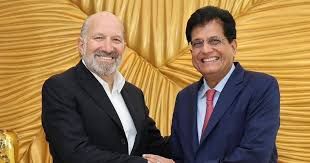What India is hoping for on US deal: Up to 20% tariff differential vis-a-vis China rate

As global trade realigns in the post-pandemic and post-China tariff war era, India is positioning itself as a key alternative manufacturing hub. In this context, the Indian government is in active discussions with the United States to finalize a trade deal that not only boosts exports but strategically places India ahead of China on tariff terms. One of New Delhi’s core demands is a 10–20% tariff differential in its favor — a move that would make Indian products significantly more competitive in the American market compared to their Chinese counterparts.
A Calculated Move: India’s Tariff Advantage Strategy
India’s request for a tariff buffer isn’t just about pricing. It’s part of a larger economic strategy to present itself as the “plus-one” in the global “China Plus One” manufacturing shift. With the United States gradually lowering tariffs on certain Chinese imports following their trade détente, Indian policymakers worry that any narrowing tariff gap could erode India’s competitive edge.
Thus, India is seeking a firm assurance from Washington: U.S. tariffs on Indian goods should be 10 to 20 percentage points lower than what China pays on comparable products. This differential, if achieved, could translate into a meaningful incentive for global buyers to shift sourcing from China to India.
The July 9 Deadline: A Looming Pressure Point
The urgency stems from an imminent deadline — July 9, 2025. That’s when new retaliatory U.S. tariffs of up to 26% on Indian goods are scheduled to take effect if negotiations don’t reach a breakthrough. These duties were introduced in response to India’s own import restrictions on American goods like apples, walnuts, and dairy items.
While India is willing to ease some of those restrictions, it wants a fair return: predictable market access, strategic exemptions, and most crucially, a locked-in tariff advantage over China.
What India Is Offering in Return
India is not entering these talks empty-handed. The government has reportedly shown willingness to cut tariffs on several American exports, including:
- High-end motorcycles
- Walnuts and almonds
- Certain auto parts
- Energy equipment and components
Moreover, New Delhi has expressed openness to facilitate greater foreign investment in critical sectors such as renewable energy, semiconductors, and defense technology, where U.S. companies have significant interest.
However, India is also drawing firm boundaries. Agriculture, dairy, and automobiles remain red lines — sectors that are politically sensitive and crucial to the rural economy.
Why the Tariff Differential Matters
For India, the 10–20% tariff differential is more than a trade ask — it’s a geopolitical necessity. Here’s why:
- Leveling the Playing Field: Indian manufacturers often face higher costs due to weaker infrastructure, longer logistics cycles, and compliance burdens. A tariff buffer could help offset these disadvantages.
- Boosting Exports: Sectors such as pharmaceuticals, textiles, electronics, and specialty chemicals stand to gain if Indian goods become cheaper and more attractive to U.S. buyers.
- Attracting Global Supply Chains: Multinational companies seeking to diversify from China are eyeing India. A sustained tariff advantage could tip the scales in India’s favor, leading to more FDI, technology transfer, and job creation.
- Strategic Decoupling: The U.S. is increasingly seeking allies to counterbalance China’s economic influence. A trade deal with India that incentivizes diversification serves both geopolitical and commercial goals.
The American Perspective
The U.S. side, too, is showing interest, though with caution. While American exporters want market access to India’s growing middle class, Washington also needs to balance domestic industry concerns, particularly around competition and labor.
Additionally, any permanent tariff concessions to India must be WTO-compliant and non-discriminatory, raising legal and procedural questions. There’s also a political calculation — upcoming elections in both countries could make negotiators risk-averse.
Yet, American policymakers acknowledge India’s rising importance. As a fellow democracy and a counterweight to China in the Indo-Pacific, India is viewed as a long-term strategic partner, not just a trade ally.
A Comprehensive Deal, Not Just a Quick Fix
While early talks hinted at a limited “early harvest” agreement to beat the July 9 tariff deadline, Indian officials are now pushing for a comprehensive trade pact. According to sources, India prefers a long-term, stable deal over a hurried, one-sided arrangement.
This means broader negotiations covering not just tariff lines, but also:
- Digital trade
- Cross-border data flows
- Customs procedures
- Investment protections
- IPR enforcement
This comprehensive approach would help build a durable economic corridor between the world’s two largest democracies — and prevent future flare-ups like the current tariff standoff.
Final Thoughts: India’s Bet on Strategic Patience
India’s ambition in these trade talks reflects a larger confidence in its economic future. No longer content with just market access, New Delhi is actively shaping trade deals that secure long-term strategic advantages, particularly in the context of shifting global supply chains.
By demanding a tariff differential with China, India is sending a clear message: it wants to be seen not just as another export economy, but as a preferred, reliable partner in the post-globalization era.
Whether the U.S. agrees remains to be seen. But for India, this deal could define the next decade of trade, investment, and strategic alignment.






